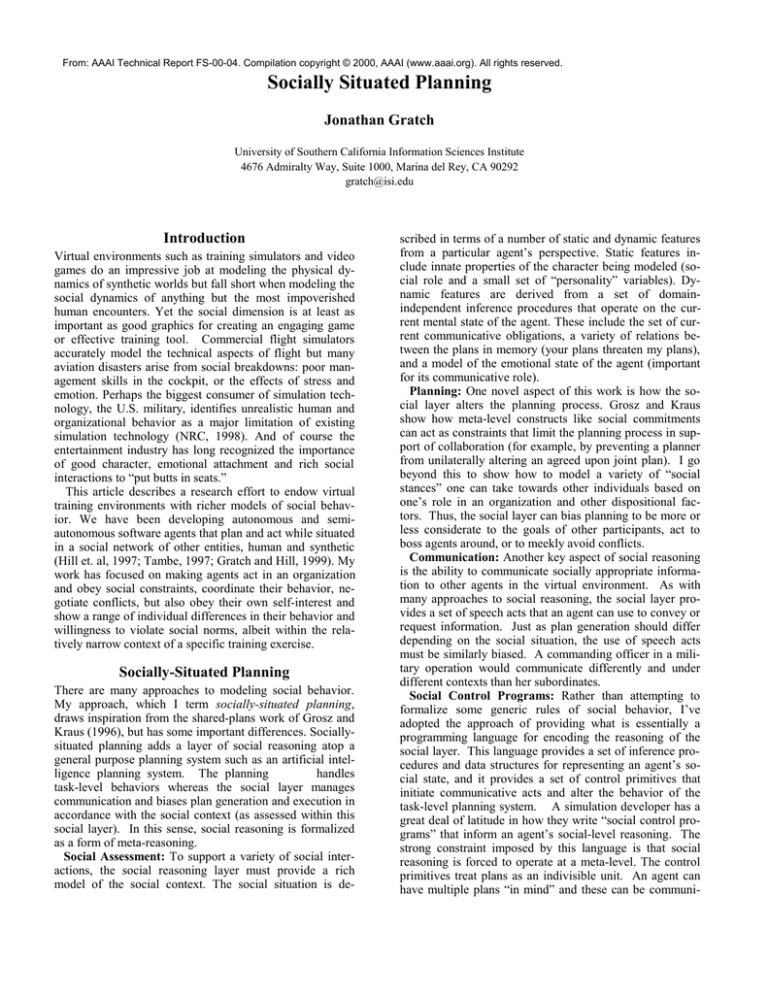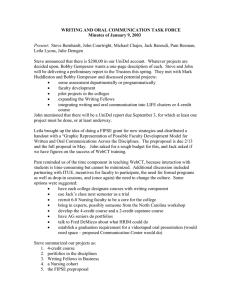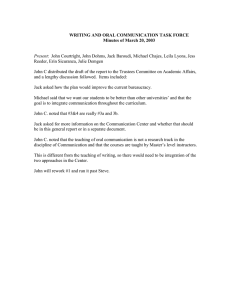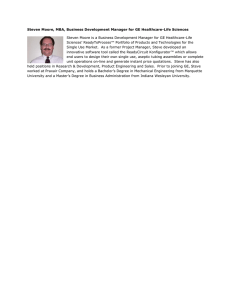
From: AAAI Technical Report FS-00-04. Compilation copyright © 2000, AAAI (www.aaai.org). All rights reserved.
Socially Situated Planning
Jonathan Gratch
University of Southern California Information Sciences Institute
4676 Admiralty Way, Suite 1000, Marina del Rey, CA 90292
gratch@isi.edu
Introduction
Virtual environments such as training simulators and video
games do an impressive job at modeling the physical dynamics of synthetic worlds but fall short when modeling the
social dynamics of anything but the most impoverished
human encounters. Yet the social dimension is at least as
important as good graphics for creating an engaging game
or effective training tool. Commercial flight simulators
accurately model the technical aspects of flight but many
aviation disasters arise from social breakdowns: poor management skills in the cockpit, or the effects of stress and
emotion. Perhaps the biggest consumer of simulation technology, the U.S. military, identifies unrealistic human and
organizational behavior as a major limitation of existing
simulation technology (NRC, 1998). And of course the
entertainment industry has long recognized the importance
of good character, emotional attachment and rich social
interactions to “put butts in seats.”
This article describes a research effort to endow virtual
training environments with richer models of social behavior. We have been developing autonomous and semiautonomous software agents that plan and act while situated
in a social network of other entities, human and synthetic
(Hill et. al, 1997; Tambe, 1997; Gratch and Hill, 1999). My
work has focused on making agents act in an organization
and obey social constraints, coordinate their behavior, negotiate conflicts, but also obey their own self-interest and
show a range of individual differences in their behavior and
willingness to violate social norms, albeit within the relatively narrow context of a specific training exercise.
Socially-Situated Planning
There are many approaches to modeling social behavior.
My approach, which I term socially-situated planning,
draws inspiration from the shared-plans work of Grosz and
Kraus (1996), but has some important differences. Sociallysituated planning adds a layer of social reasoning atop a
general purpose planning system such as an artificial intelligence planning system. The planning system handles
task-level behaviors whereas the social layer manages
communication and biases plan generation and execution in
accordance with the social context (as assessed within this
social layer). In this sense, social reasoning is formalized
as a form of meta-reasoning.
Social Assessment: To support a variety of social interactions, the social reasoning layer must provide a rich
model of the social context. The social situation is de-
scribed in terms of a number of static and dynamic features
from a particular agent’s perspective. Static features include innate properties of the character being modeled (social role and a small set of “personality” variables). Dynamic features are derived from a set of domainindependent inference procedures that operate on the current mental state of the agent. These include the set of current communicative obligations, a variety of relations between the plans in memory (your plans threaten my plans),
and a model of the emotional state of the agent (important
for its communicative role).
Planning: One novel aspect of this work is how the social layer alters the planning process. Grosz and Kraus
show how meta-level constructs like social commitments
can act as constraints that limit the planning process in support of collaboration (for example, by preventing a planner
from unilaterally altering an agreed upon joint plan). I go
beyond this to show how to model a variety of “social
stances” one can take towards other individuals based on
one’s role in an organization and other dispositional factors. Thus, the social layer can bias planning to be more or
less considerate to the goals of other participants, act to
boss agents around, or to meekly avoid conflicts.
Communication: Another key aspect of social reasoning
is the ability to communicate socially appropriate information to other agents in the virtual environment. As with
many approaches to social reasoning, the social layer provides a set of speech acts that an agent can use to convey or
request information. Just as plan generation should differ
depending on the social situation, the use of speech acts
must be similarly biased. A commanding officer in a military operation would communicate differently and under
different contexts than her subordinates.
Social Control Programs: Rather than attempting to
formalize some generic rules of social behavior, I’ve
adopted the approach of providing what is essentially a
programming language for encoding the reasoning of the
social layer. This language provides a set of inference procedures and data structures for representing an agent’s social state, and it provides a set of control primitives that
initiate communicative acts and alter the behavior of the
task-level planning system. A simulation developer has a
great deal of latitude in how they write “social control programs” that inform an agent’s social-level reasoning. The
strong constraint imposed by this language is that social
reasoning is forced to operate at a meta-level. The control
primitives treat plans as an indivisible unit. An agent can
have multiple plans “in mind” and these can be communi-
cated and treated differently by the planner, but the sociallayer cannot manipulate or refer to the contents of these
plans directly. This concept will be made clearer in the
discussion below. These social control programs can be
viewed as defining a finite state machine that changes the
state of the set of control primitives based on features of the
social context. In the examples in this article this state machine is defined in terms of a set of condition action rules,
although in one application these state transitions have been
formalized in terms of STRIPS-style planning operators
and the social-program actually synthesized by the planning
system (Gratch and Hill, 1999).
Illustration
This approach has been used to model the behavior of
military organizations in the context of a training system
(Gratch and Hill, 1999) but the following contrived example provides a clear view of the capabilities of the system.
In this example, two synthetic characters, Jack and Steve,
interact with each other in the service of their own conflicting goals. The interaction is determined dynamically as
the agents interact with each other, but is also informed by
static information such as the social stance they take towards one another.
These agents are embodied in a distributed virtual environment developed by Rickel and Johnson (1999) that
provides a set of perceptual, communicative and motor
processes as well as a model of cognition. In this example,
I’ve replaced their model of cognition with my situatedplanning approach. The agents share certain task level
knowledge encoded as STRIPS-style operators. They know
how to drive vehicles to different locations, how to surf,
and how to buy lottery tickets. They also have individual
differences. They have differing goals, have varying social
status and view their relationship with each other somewhat
differently.
Jack’s goal is to make money, he views Steve as a friend,
and treats him fairly. Steve wants to surf, views Jack as a
friend, but is rude. All of these terms have a specific technical definition discussed below. Both agents develop different plans but have to contend with a shared resource.
Besides performing task level actions, the agents engage in
speech acts and generate gestures, facial expressions, and
affective speech modulation based on properties of their
social state.
What follows are annotated traces of two separate runs of
the system where the only difference is a change in the
"personality" of the Steve agent. In the first trace he treats
Jack rudely, in the second he treats him fairly. The text
generation is extremely simplistic and agents actually
communicate with each other through a more stylized plancommunication language.
Rude Interaction:
Jack: I want to make-some-big-money. [Creates a new plan containing this goal. Looks concerned, scratches his head, then,
after devising a plan looks hopeful.]
Steve: I want to catch-some-waves. [Creates a new plan containing this goal. Looks concerned, scratches head, and continues to look concerned. Surfing is important to Steve and he cannot devise a plan.]
Jack: [Perceives Steve’s emotional expression and generates an
information request.] Hey Steve, what’s wrong?
Steve: [Locates the appraisal generating the most intense negative emotional excitation. Communicates the associated plan in a
distressed tone of voice.] I want to catch some waves but can’t
find any good breakers.
Jack: [Adds Steve’s plat into plan memory and locates relevant
information. Jack was previously told of a “plan” that establishes Steve’s blocked subgoal] Steve, does it help that someone
did say there’s some great waves near the pier?
Steve: [Incorporates the communicated plan fragment.
pletes a plan to go surfing and looks hopeful.]
Com-
Jack: [Perceives Steve’s change in expression and seeks to confirm his expectation that the information he provided helped
Steve.] So that information helped?
Steve: [Handles Jack’s request.] Yes Jack. I plan to drive the car
to the beach, then I plan to surf-my-brains-out.
Jack: [Incorporates Steve’s revised plan and finds a conflict with
his own plans. Based on personality, Jack attempts to negotiate a
fair solution.] Wait a second. Our plans conflict. I plan to drive
the car to the quicky-mart then I plan to buy a-lottery-ticket.
Steve: [Incorporates Jack’s plan and recognizes the same interaction. Based on personality model, Steve responds to interaction differently. He devises a plan that satisfies his own goals
without regard to any conflicts it may introduce in Jack’s plans.
Steve exits stage right.] Later dude, I’m driving the car to the
beach.
Jack: [Perceives that car has departed without him. Looks angry.
Says in angry voice:] I want to kill-my-roommate.
Cooperative Interaction:
Jack: [Incorporates Steve’s revised plan and finds a conflict with
his own plans. Based on personality, Jack attempts to negotiate a
fair solution.] Wait a second. Our plans conflict. I plan to drive
the car to the-quicky-mart then I plan to buy a-lottery-ticket.
Steve: [Incorporates Jack’s plan and recognizes the same interaction. Based on Steve having somewhat lower social status, he
takes the initiative in repairing the conflict.] Well, I could change
my plans. [Looks concerned, scratches head, then devises a possible joint plan.] I have a suggestion. Could you drive the car to
the-quicky-mart with-me then I could drive the car to the beach.
[Note that neither agent has been given the goal of returning
home.]
Jack: [Incorporates Steve’s suggested joint plan, determines that
it is consistent with his own plans, and agrees to form a joint
commitment to the shared plan.] Sounds good to me.
Social Control Programs
A small change in an agent’s static social state can result in
a dramatic change in behavior because reasoning at the
social level is highly leveraged. Social reasoning is conditioned on dynamic social features that encapsulate a good
deal of domain-independent inference and social control
primitives allow for considerable differences in how plans
are generated and executed at the base level. Social reasoning is represented as a set of condition actions rules that
operate at this meta-layer. Social state components serve as
the conditions for these social rules whereas control primitives define the space of possible actions.
1.1 Social State
An agent’s social state is divided into dynamic and static
components. Dynamic components are further divided into
communicative state, plan state, and emotional state.
Communicative State: The communicative state tracks
what information has been communicated to different
agents and maintains any communicative obligations that
arise from speech acts. When Steve communicates a plan
to Jack, Steve’s social layer records that Jack knows this
plan, and persists in knowing it until Steve’s planning layer
modifies it, at which point Steve’s social layer records that
Jack’s knowledge is out of date. If Jack requests Steve’s
current plans, the social layer creates communicative obligations: the fact that Steve owes Jack a response is recorded in each agent’s social layer (though whether Steve
satisfies this obligation is up to Steve’s social control program).
Plan State: At the base-level planning layer, all activities
that an agent is aware of (whether they come from its own
planning or are communicated from outside) are stored in a
single plan network, allowing the planner to reason about
the interrelationship between these activities. The social
layer keeps track of the fact that different subsets of this
plan network correspond to different plans – some belonging to the agent and some corresponding to (what the agent
believes to be) plans of other agents. The social layer also
computes a variety of high-level relations between plans.
Plans can contain threats and the plans of one agent can
introduce threats or be threatened by the plans of another
agent (such relations are computed using the basic planevaluation routines provided by standard planning systems). Plans of one agent can also be relevant to the plans
of other agents (as computed by the plan-relevance criteria
proposed by desJardins and Wolverton, 1998). Plans may
be interdependent in the sense that one depends on effects
produced by another.
Emotional State: The social layer incorporates a model
of emotional reasoning, Émile, that derives an emotional
state from syntactic properties of an agent’s plans in memory (Gratch, 2000). Émile adopts the cognitive view of
emotions as a form of plan evaluation, relating events to an
agent’s current goals (c.f., Ortony et al, 1988; Lazarus,
1991). Émile can compute an agent’s overall state, track
the emotions arising from a specific plan, and make inferences about the emotional state of other agents (given an
understanding of their goals and plans). Emotional state is
represented as a real-valued vector representing the intensities of different emotional states (Fear, Joy, etc.) and Émile
dynamically modifies this state based on the current world
situation and the state of plans in memory.
Static State: Static social state components describe
characteristics of an agent that are invariant in the course of
a simulation. These components can be rather arbitrary and
act simply as conditions to be tested by the social control
program. The “personality gui” mentioned above implements five static state components. One can manipulate an
agent’s top level goals, its social status, its etiquette (its
sensitivity to certain social cues), its independence (is it
willing to construct plans that depend on the activities of
other agents), and characteristics of its relationship with
other agents (friendly, adversarial, rude, deferential, etc.).
1.2 Control Primitives
Control primitives define the set of actions one can associate with the social level. These primitives are sub-divided
into communicative primitives and plan-control primitives.
Communicative Primitives: The social layer defines a
set of speech acts that an agent may use to communicate
with other agents. As they are defined at the meta-level,
they can operate on plans only as an atomic structure and
cannot make reference to components of a plan (although
one has the option of breaking a plan into explicit subplans). Some speech acts serve to communicate plans (one
can INFORM another agent of one plans, REQUEST that
they accept some plan of activity, etc.). Other speech acts
serve to change the state of some previously communicated
plan (one can state that some plan is under revision, that a
plan is acceptable, that it should be forgotten, etc.).
Planning Primitives: Planning primitives alter the way
the planner treats activities within a base-level plan. Classical planning algorithms can be viewed as a sequential
decision process: some critiquing routines identify a set of
problems with the current plan network and propose a set
of modifications that resolve at least one of these problems
(an action should be added, these actions should be reordered, etc.); one modification is applied and the process
continues. Planning primitives act by constraining the set
of viable modifications.
Recall that from the perspective of the planning algorithm, all activities are represented in a single task network
(whether they belong to the agent or represent the activities
of other entities). One set of planning primitives allows
one to create and manipulate plan objects. Plans can be
created and destroyed, and they can be populated with new
goals and with activities communicated by other agents.
Another set of planning primitives determines whether the
planning algorithm can modify the activities in one of these
plan objects. One can make a plan modifiable, allowing the
planner to fix any flaws with that plan, or one can freeze its
current state (as when adopting a commitment to a certain
course of action. One can also modify the execution status
of the plan, enabling or disabling the execution of actions
within it.
Finally, another set of planning primitives alters the way
the planner handles interactions between plans and thereby
implements the idea of a social stance. For example, what
happens when Steve detects that his plan conflicts with
Jack's. He has several options. He could adopt a rude
stance towards Jack, running to grab the keys before Jack
gets a chance to take the car. This essentially corresponds
to a strategy where the planner resolves any threats that
Jack introduces into Steve’s plans, but ignores any threats
that Steve introduces into Jack’s. Alternatively, Steve could
take a meek stance, finding some other ways to get to the
beach or simply staying home. This corresponds to a strategy where the planner treats Jack’s plans as immutable,
resolves any threats to Jack’s plans, and tries to work
around any threats that Jack introduces into Steve’s plans.
Steve could be helpful, adding activities to his plan that
ensures that Jack gets to the market. Or he could be
authoritative, demanding that Jack drive him to the beach
(by inserting activities into Jack’s plans). These stances are
all implemented as search control, limiting certain of a
planner’s threat resolution options.
The following are a few paraphrased examples of rules
that make up Steve and Jack’s social control program. The
current implementation has about thirty such rules:
Social-Rule: plan-for-goal
IF I have a top-level goal, ?goal, who’s predicate is
?p THEN
Do-Gesture(Thinking)
Say(to-self, "I want to ?predicate")
?plan = create-new-plan()
populate-plan(?plan, ?goal)
enable-modification(?plan)
Social-Rule: help-friend
IF I have a plan, ?plan, that is relevant-to the plan of
another agent, ?agent, I am friends with that agent, I
am socially adept, and the plan is not already known
to that agent THEN
Do-Gesture(Look-at ?agent)
SpeechAct(FACILLITATE, ?plan ?agent)
Social-Rule: you-cause-problems-for-me
IF my plan, ?plan, is threatened by your plan and I
don’t have an obligation to revise my plan and you
don’t have an obligation to revise your plan and you
don’t know my plan THEN
Say(?you, "Wait a second, our plans conflict")
SpeechAct(INFORM_PROB, ?plan, ?you)
Summary
Socially situated planning provides one mechanism for improving the social awareness of agents. Obviously this
work is in the preliminary stages and many of the limitation
and the relationship to other work could not be addressed in
such a short article. The chief limitation, of course, is the
strong commitment to defining social reasoning solely at
the meta-level, which restricts the subtlety of social behavior. Nonetheless, our experience in some real-world military simulation applications suggest that the approach, even
in its preliminary state, is adequate to model some social
interactions, and certainly extends the state-of-the art found
in traditional training simulation systems.
Acknowledgements
I greatly benefited from discussions with Stacy Marsella and Paul
Rosenboom. Thanks to Jeff Rickel for letting me steal his bodies.
Clark Elliott, Jeff Rickel, Lewis Johnson, Celia Pearce, Kate LaBore, Wendy Hui Kyong, and Ricardo Dominguez gave greate
comments, insights, and suggestions. This research was funded
by the Army Research Institute under contract TAPC-ARI-BR
References
desJardins, M. & Wolverton, M. 1998. Coordinating planning
activity and information flow in a distributed planning system. AAAI Fall Symposium on Distributed Continual Planning.
Gratch, J. and Hill, R. 1999. "Continous Planning and Collaboration for Command and Control in Joint Synthetic Battlespaces." 8th Conference on Computer Generated Forces
and Behavioral Representation.
Grosz, B., and Kraus, S. 1996. “Collaborative Plans for Complex Group Action,” Artificial Intelligence, 86(2).
Hill, R., Chen, J., Gratch, G., Rosenbloom, P., and Tambe, M.
1997. “Intelligent Agents for the Synthetic Battlefield,” in
AAAI-97/IAAI-97, pp. 1006-1012
Lazarus, R.S. 1991. Emotion and Adaptation. Oxford Prs
National Research Council (NRC), 1998. Modeling Human
and Organizational Behavior. National Academy Press,
Washington D.C.
Ortony A., Clore, G. L., & Collins, A. 1988. The Cognitive
Structure of Emotions. Cambridge University Press.
Pell, B. Bernard, D., Chien, S., Gat, E., Muscettola, N.,
Nayak, P. P., Wagner, M., Williams, B. 1998. An autonomous
spacecraft agent prototype Autonomous Robotics, 5.
Rickel, J. and Johnson, L. 1998. "Animated Agents for Procedural Training in Virtual Reality: Perception, Cognition,
and Motor Control." Applied Artificial Intelligence (13).
Tambe, M. 1997. “Agent Architectures for Flexible,
Practical Teamwork,” in AAAI-97, pp. 22-28.



